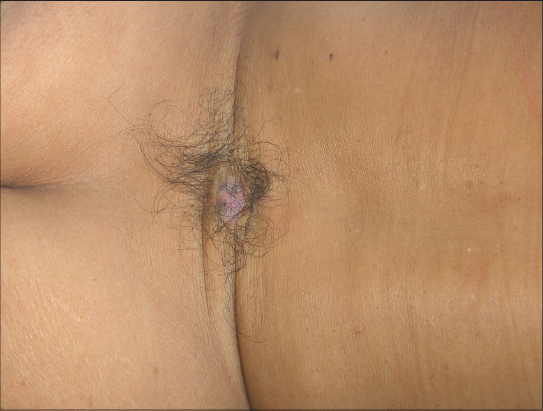|
|
Vascular tumor and hypertrichosis as skin markers of occult spinal dysraphism
Mohammed Chaouche , Younes Barbach, Abdellah Dah Cherif, Sara Elloudi, Hanane Baybay, Fatima Zahra Mernissi
, Younes Barbach, Abdellah Dah Cherif, Sara Elloudi, Hanane Baybay, Fatima Zahra Mernissi
Department of Dermatology and Venereology, University Hospital Hassan II, Fez, Morocco
Corresponding author: Dr. Mohammed Chaouche, MD, E-mail: medch11@hotmail.com
Submission: 23.01.2019; Acceptance: 25.03.2019
DOI: 10.7241/ourd.2019e.10
Cite this article: Chaouche M, Barbach Y, Cherif AD, Elloudi S, Baybay H, Mernissi FZ. Vascular tumor and hypertrichosis as skin markers of occult spinal dysraphism. Our Dermatol Online. 2019;10(e):e10.1.
Copyright information
© Our Dermatology Online 2019. No commercial re-use. See rights and permissions. Published by Our Dermatology Online.
Spina bifida is a congenital disorder with incomplete closure of the spinal column due to a bony vertebral defect. It is a midline defect that occurs during the embryonic period. Depending on the extent of the neural tube defect, various types of spina bifida can be differentiated. Spina bifida occulta, are solely characterized by a bony defect of the vertebral arch, whereas, spina bifida cystica can be distinguished by a protruding cyst, containing either meninges or meninges in combination with spinal cord tissue and are defined as open spinal dysraphisms [1]. The cutaneous manifestations accompanying spinal dysraphism that may lead to early recognition of this syndrome and early institution of treatment [2]. A 42-year-old female patient, without history, has developed since birth a nodular vascular firm tumor measuring 25 mm with hypertrichosis in the median lumbar skin (Fig. 1). The neurological examination did not reveal any deficit, especially concerning lower limbs, the complementary explorations in favor of spina bifida occulta.
Consent
The examination of the patient was conducted according to the Declaration of Helsinki principles.
REFERENCES
1. Seromenho-Santos A, Valsassina R, Pimentel J, Miguéns J, Faria CC. Lumbar pseudo-tail associated with dermal sinus –A case report. Neurocirugia (Astur). 2017;28:294-7.
2. Tavafoghi V, Ghandchi A, Hambrick GW, Udverhelyi GB. Cutaneous Signs of Spinal Dysraphism:Report of a Patient With a Tail-like Lipoma and Review of 200 Cases in the Literature. Arch Dermatol. 1978;114:573–7.
Notes
Source of Support: Nil
Conflict of Interest: None declared.
Request permissions
If you wish to reuse any or all of this article please use the e-mail (brzezoo77@yahoo.com) to contact with publisher.
| Related Articles | Search Authors in |
|
 http://orcid.org/000-0003-3455-3810 http://orcid.org/000-0003-3455-3810
|



Comments are closed.